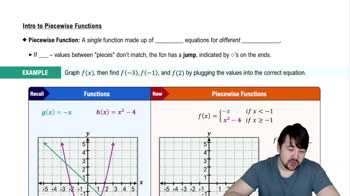Table of contents
- 0. Functions7h 52m
- Introduction to Functions16m
- Piecewise Functions10m
- Properties of Functions9m
- Common Functions1h 8m
- Transformations5m
- Combining Functions27m
- Exponent rules32m
- Exponential Functions28m
- Logarithmic Functions24m
- Properties of Logarithms34m
- Exponential & Logarithmic Equations35m
- Introduction to Trigonometric Functions38m
- Graphs of Trigonometric Functions44m
- Trigonometric Identities47m
- Inverse Trigonometric Functions48m
- 1. Limits and Continuity2h 2m
- 2. Intro to Derivatives1h 33m
- 3. Techniques of Differentiation3h 18m
- 4. Applications of Derivatives2h 38m
- 5. Graphical Applications of Derivatives6h 2m
- 6. Derivatives of Inverse, Exponential, & Logarithmic Functions2h 37m
- 7. Antiderivatives & Indefinite Integrals1h 26m
1. Limits and Continuity
Finding Limits Algebraically
Problem 73c
Textbook Question
Let f(x) = {x^2+1 / if x<−1
√x+1 if x≥−1.
Compute the following limits or state that they do not exist.
limx→−1 f(x)
 Verified step by step guidance
Verified step by step guidance1
<insert step 1> Identify the piecewise function f(x) and the point of interest, which is x = -1. The function is defined as f(x) = x^2 + 1 for x < -1 and f(x) = \sqrt{x} + 1 for x \geq -1.
<insert step 2> To find the limit as x approaches -1, consider the left-hand limit (as x approaches -1 from the left) and the right-hand limit (as x approaches -1 from the right) separately.
<insert step 3> Calculate the left-hand limit: lim_{x \to -1^-} f(x) = lim_{x \to -1^-} (x^2 + 1). Substitute x = -1 into the expression x^2 + 1 to find the left-hand limit.
<insert step 4> Calculate the right-hand limit: lim_{x \to -1^+} f(x) = lim_{x \to -1^+} (\sqrt{x} + 1). Substitute x = -1 into the expression \sqrt{x} + 1 to find the right-hand limit.
<insert step 5> Compare the left-hand and right-hand limits. If they are equal, the limit exists and is equal to this common value. If they are not equal, the limit does not exist.
Recommended similar problem, with video answer:
 Verified Solution
Verified SolutionThis video solution was recommended by our tutors as helpful for the problem above
Video duration:
2mPlay a video:
Was this helpful?
Key Concepts
Here are the essential concepts you must grasp in order to answer the question correctly.
Piecewise Functions
A piecewise function is defined by different expressions based on the input value. In this case, f(x) has two distinct formulas: one for x < -1 and another for x ≥ -1. Understanding how to evaluate piecewise functions is crucial for determining limits at points where the function's definition changes.
Recommended video:

Piecewise Functions
Limits
A limit describes the behavior of a function as the input approaches a certain value. To compute the limit of f(x) as x approaches -1, we need to evaluate the function from both sides of -1, using the appropriate piece of the function for each side. This helps us determine if the limit exists and what its value is.
Recommended video:

One-Sided Limits
Left-Hand and Right-Hand Limits
Left-hand and right-hand limits refer to the values that a function approaches as the input approaches a specific point from the left or right, respectively. For the limit of f(x) as x approaches -1, we must calculate the left-hand limit (using x < -1) and the right-hand limit (using x ≥ -1) to see if they are equal, which would indicate the overall limit exists.
Recommended video:

One-Sided Limits

 5:21m
5:21mWatch next
Master Finding Limits by Direct Substitution with a bite sized video explanation from Callie
Start learningRelated Videos
Related Practice







